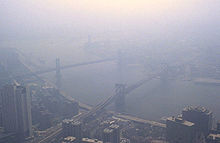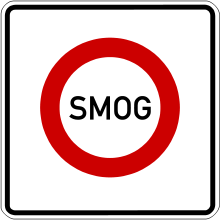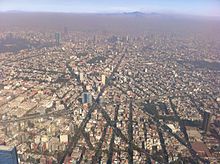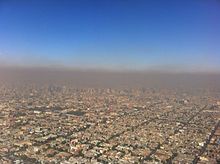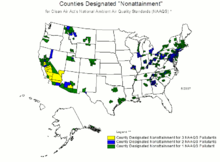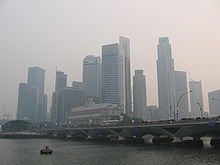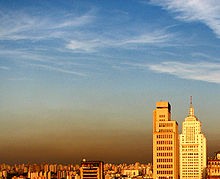
Smog
Background to the schools Wikipedia
This wikipedia selection has been chosen by volunteers helping SOS Children from Wikipedia for this Wikipedia Selection for schools. Sponsoring children helps children in the developing world to learn too.
Smog is a type of air pollution; the word "smog" was made in the early 20th century as a portmanteau of the words smoke and fog to refer to smoky fog. The word was then intended to refer to what was sometimes known as pea soup fog, a familiar and serious problem in London from the 19th century to the mid 20th century. This kind of smog is caused by the burning of large amounts of coal within a city; this smog contains soot particulates from smoke, sulfur dioxide and other components. Modern smog, as found for example in Los Angeles, is a type of air pollution derived from vehicular emission from internal combustion engines and industrial fumes that react in the atmosphere with sunlight to form secondary pollutants that also combine with the primary emissions to form photochemical smog. The atmospheric pollution levels of Los Angeles, Mexico City and other cities are increased by inversion that traps pollution close to the ground.
Etymology
Coinage of the term "smog" is generally attributed to Dr. Henry Antoine Des Voeux in his 1905 paper, "Fog and Smoke" for a meeting of the Public Health Congress. The July 26, 1905 edition of the London newspaper Daily Graphic quoted Des Voeux, "He said it required no science to see that there was something produced in great cities which was not found in the country, and that was smoky fog, or what was known as 'smog.'" The following day the newspaper stated that "Dr. Des Voeux did a public service in coining a new word for the London fog." "Smog" also appears in a January 19, 1893, Los Angeles Times article and is attributed to "a witty English writer."
Photochemical smog
Photochemical smog was first described in the 1950s. It is the chemical reaction of sunlight, nitrogen oxides and volatile organic compounds in the atmosphere, which leaves airborne particles and ground-level ozone. This noxious mixture of air pollutants can include the following:
- Aldehydes
- Nitrogen oxides, such as nitrogen dioxide
- Peroxyacyl nitrates
- Tropospheric ozone
- Volatile organic compounds
All of these chemicals are usually highly reactive and oxidizing. Photochemical smog is therefore considered to be a problem of modern industrialization. It is present in all modern cities, but it is more common in cities with sunny, warm, dry climates and a large number of motor vehicles. Because it travels with the wind, it can affect sparsely populated areas as well.

Health effects

Smog is a serious problem in many cities and continues to harm human health. Ground-level ozone, sulfur dioxide, nitrogen dioxide and carbon monoxide are especially harmful for senior citizens, children, and people with heart and lung conditions such as emphysema, bronchitis, and asthma. It can inflame breathing passages, decrease the lungs' working capacity, cause shortness of breath, pain when inhaling deeply, wheezing, and coughing. It can cause eye and nose irritation and it dries out the protective membranes of the nose and throat and interferes with the body's ability to fight infection, increasing susceptibility to illness. Hospital admissions and respiratory deaths often increase during periods when ozone levels are high.
The U.S. EPA has developed an Air Quality Index to help explain air pollution levels to the general public. 8 hour average ozone concentrations of 85 to 104 ppbv are described as "Unhealthy for Sensitive Groups", 105 ppbv to 124 ppbv as "unhealthy" and 125 ppb to 404 ppb as "very unhealthy". The "very unhealthy" range for some other pollutants are: 355 μg m−3 - 424 μg m−3 for PM10; 15.5 ppm - 30.4ppm for CO and 0.65 ppm - 1.24 ppm for NO2.
The Ontario Medical Association announced that smog is responsible for an estimated 9,500 premature deaths in the province each year.
A 20-year American Cancer Society study found that cumulative exposure also increases the likelihood of premature death from a respiratory disease, implying the 8-hour standard may be insufficient.
Areas affected

Smog can form in almost any climate where industries or cities release large amounts of air pollution, such as smoke or gases. However, it is worse during periods of warmer, sunnier weather when the upper air is warm enough to inhibit vertical circulation. It is especially prevalent in geologic basins encircled by hills or mountains. It often stays for an extended period of time over densely populated cities or urban areas, and can build up to dangerous levels.
London, United Kingdom

In 1306, concerns over air pollution were sufficient for Edward I to (briefly) ban coal fires in London. In 1661, John Evelyn's Fumifugium suggested burning fragrant wood instead of mineral coal, which he believed would reduce coughing. The Ballad of Gresham College the same year describes how the smoke "does our lungs and spirits choke, Our hanging spoil, and rust our iron."
Severe episodes of smog continued in the 19th and 20th centuries, mainly in the winter, and were nicknamed "pea-soupers". The Great Smog of 1952 darkened the streets of London and killed approximately 4,000 people in the short time of 4 days (a further 8,000 died from its effects in the following weeks and months). Initially a flu epidemic was blamed for the loss of life.
In 1956 the Clean Air Act started legally enforcing smokeless zones in the capital. There were areas where no soft coal was allowed to be burned in homes or in businesses, only coke, which produces no smoke. Because of the smokeless zones, reduced levels of sooty particulates made the intense and persistent London smog a thing of the past.
It was after this that the great clean-up of London began. One by one, historical buildings which, during the previous two centuries had gradually completely blackened externally, had their stone facades cleaned and restored to their original appearance. Victorian buildings whose appearance changed dramatically after cleaning included the British Museum of Natural History. A more recent example was the Palace of Westminster, which was cleaned in the 1980s. Smog caused by traffic pollution, however, does still occur in modern London.
Mexico City, Mexico
Due to its location in a highland "bowl", cold air sinks down onto the urban area of Mexico City, trapping industrial and vehicle pollution underneath, and turning it into the most infamously smog-plagued city of Latin America. Within one generation, the city has changed from being known for some of the cleanest air of the world into one with some of the worst pollution, with pollutants like nitrogen dioxide being double or even triple international standards.
Santiago, Chile
Similar to Mexico City, the air pollution of Santiago valley located between the Andes and Chilean Coast Range turning it into the most infamously smog-plagued city of South America. Other aggravant of the situation resides in its high latitude (31 degrees South) and dry weather at most part of the year.
Tehran, Iran
In December 2005, schools and public offices had to close in Tehran, Iran and 1600 people were taken to hospital, in a severe smog blamed largely on unfiltered car exhaust.
United States
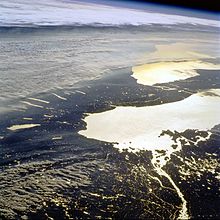
Smog was brought to the attention of the general US public in 1933 with the publication of the book "Stop That Smoke", by Henry Obermeyer, a New York public utility official, in which he pointed out the effect on human life and even the destruction of 3,000 acres (12 km2) of a farmer's spinach crop. Since then, the United States Environmental Protection Agency has designated over 300 U.S. counties to be non-attainment areas for one or more pollutants tracked as part of the National Ambient Air Quality Standards. These areas are largely clustered around large metropolitan areas, with the largest contiguous non-attainment zones in California and the Northeast. Various U.S. and Canadian government agencies collaborate to produce real-time air quality maps and forecasts.
Los Angeles and the San Joaquin Valley
Because of their locations in low basins surrounded by mountains, Los Angeles and the San Joaquin Valley are notorious for their smog. The millions of vehicles in these regions combined with the additional effects of the San Francisco Bay and Los Angeles/ Long Beach port complexes frequently contribute to further air pollution. While strict regulations by numerous California government agencies overseeing this problem have decreased the number of Stage 1 smog alerts from several hundred annually to just a few, these geologically predisposed entrapment zones collect pollution levels from cars, trucks and fixed sources which still exceeds health standards and is a pressing issue for the more than 25 million people who live there.
Major incidents in the US
- 1948, October 30–31, Donora, PA: 20 died, 600 hospitalized, thousands more stricken. Lawsuits were not settled until 1951.
- 1953, November, New York: Smog kills between 170 and 260 people.
- 1954, October, Los Angeles: heavy smog shuts down schools and industry for most of the month.
- 1963, New York: blamed for 200 deaths
- 1966, New York: blamed for 169 deaths
Ulaanbaatar, Mongolia
In the late 1990s massive immigration to Ulaanbaatar from the countryside began. An estimated 150,000 households, mainly living in traditional Mongolian gers on the outskirts of Ulaanbaatar, burn wood and coal (some poor families burn even car tyres and trash) to heat themselves during the harsh winter, which lasts from October to April, since these outskirts are not connected to the city's central heating system. A temporary solution to decrease smog was proposed in the form of stoves with improved efficiency, although with no visible results. Coal-fired ger stoves release high levels of ash and other particulate matter (PM). When inhaled, these particles can settle in the lungs and respiratory tract and cause health problems. At two to 10 times above Mongolian and international air quality standards, Ulaanbaatar's PM rates are among the worse in the world, according to a December 2009 World Bank report. The Asian Development Bank (ADB) estimates that health costs related to this air pollution account for as much as 4 percent of Mongolia's GDP.
Southeast Asia
Smog is a regular problem in Southeast Asia caused by land and forest fires in Indonesia, especially Sumatra and Kalimantan, although the term haze is preferred in describing the problem. Farmers and plantation owners are usually responsible for the fires, which they use to clear tracts of land for further plantings. Those fires mainly affect Brunei, Indonesia, Philippines, Malaysia, Singapore and Thailand, and occasionally Guam and Saipan. The economic losses of the fires in 1997 have been estimated at more than US$9 billion. This includes damages in agriculture production, destruction of forest lands, health, transportation, tourism, and other economic endeavours. Not included are social, environmental, and psychological problems and long-term health effects. The latest bout of haze to occur in Malaysia, Singapore and the Malacca Straits is in October 2006, and was caused by smoke from fires in Indonesia being blown across the Straits of Malacca by south-westerly winds.
The Association of Southeast Asian Nations (ASEAN) reacted and signed Agreement on Transboundary Haze Pollution, formed a Regional Haze Action Plan (RHAP) and established a co-ordination and support unit (CSU). RHAP, with the help of Canada, established a monitoring and warning system for forest/vegetation fires and implemented a Fire Danger Rating System (FDRS). The Malaysian Meteorological Service (MMS) has issued a daily rating since September 2003. The Indonesians have been ineffective at enforcing legal policies on errant farmers.
Natural causes
An erupting volcano can also emit high levels of sulphur dioxide along with a large quantity of particulate matter; two key components to the creation of smog. However, the smog created as a result of a volcanic eruption is often known as vog to distinguish it as a natural occurrence.
The radiocarbon content of some plant life has been linked to the distribution of smog in some areas. For example; presence of Creosote bush in the Los Angeles area has been shown to have an effect on smog distribution that is more than fossil fuel combustion alone.
Pollution index
The severity of smog is often measured using automated optical instruments such as Nephelometers, as haze is associated with visibility and traffic control in ports. Haze however can also be an indication of poor air quality though this is often better reflected using accurate purpose built air indexes such as the American Air Quality Index, the Malaysian API (Air Pollution Index) and the Singaporean Pollutant Standards Index.
In hazy conditions, it is likely that the index will report the suspended particulate level. The disclosure of the responsible pollutant is mandated in some jurisdictions.
The Malaysian API does not have a capped value; hence its most hazardous readings can go above 500. Above 500, a state of emergency is declared in the affected area. Usually, this means that non-essential government services are suspended, and all ports in the affected area are closed. There may also be prohibitions on private sector commercial and industrial activities in the affected area excluding the food sector. So far, state of emergency rulings due to hazardous API levels were applied to the Malaysian towns of Port Klang, Kuala Selangor and the state of Sarawak during the 2005 Malaysian haze and the 1997 Southeast Asian haze.

